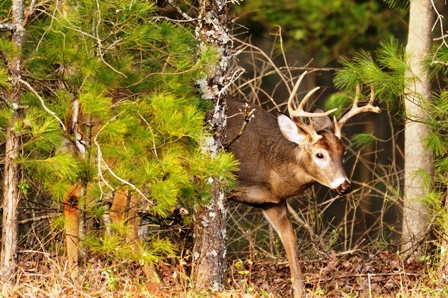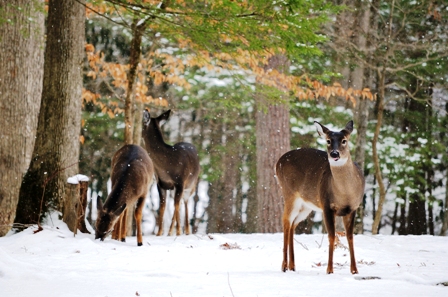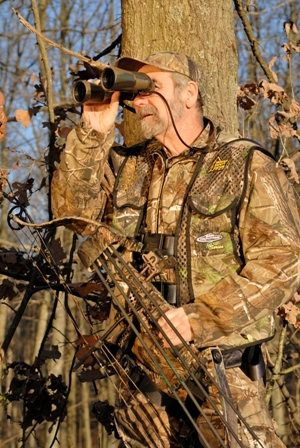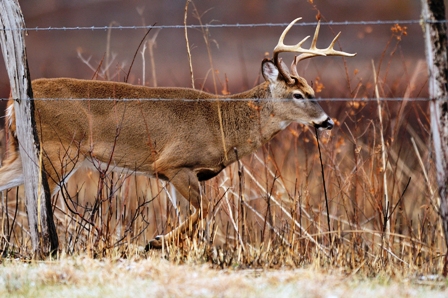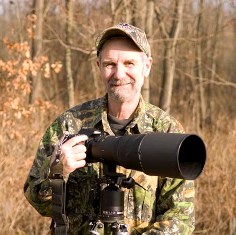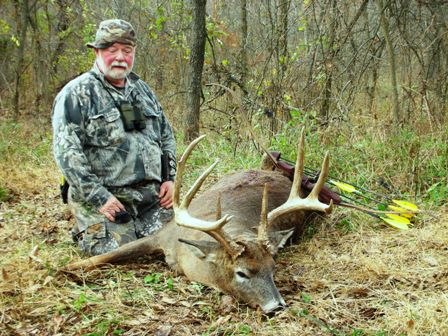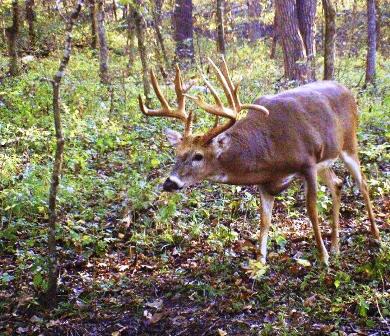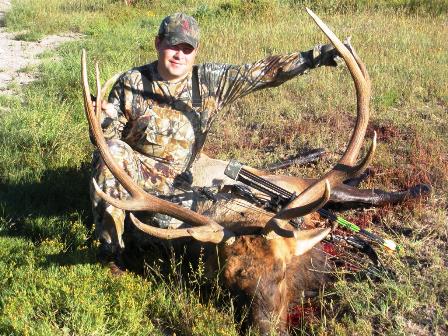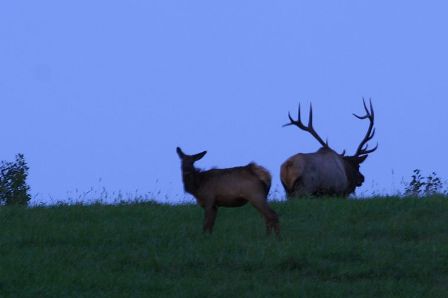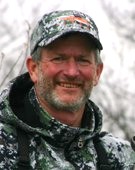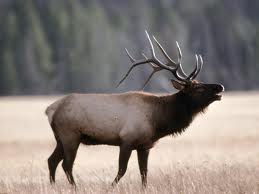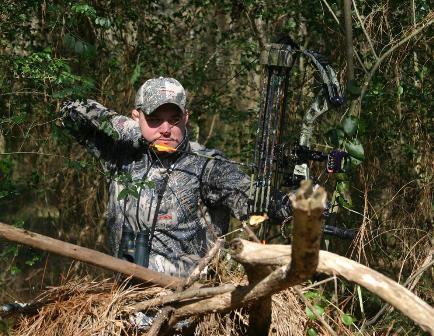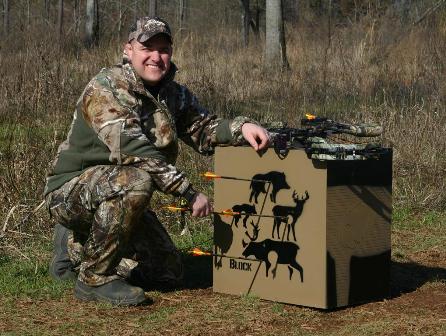By John Trout, Jr.
5 Valuable tips on how to to decipher travel corridors!
Over the years, I’ve hunted both big woods and agricultural areas. Without a doubt, I’ve found it easier to pattern bucks and hunt them effectively in the agricultural regions where “natural travel zones” are found. Most people call them “funnels”.
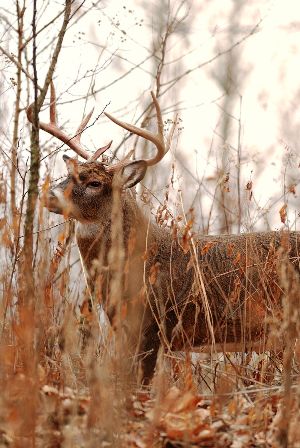
Bucks travel funnels if they link to food sources and bedding areas, but even better, they know the funnel could put them on the trail of a hot doe. (Photo by John & Vikki Trout)
Before going on, I should say that hunting funnels is effective only if you have a sound understanding of which ones provide the best opportunity. Some funnels are used very little. Others seem fool-proof if the right ingredients exist.
1 – Why Funnels Work
It’s no big secret that funnels work, but why are deer attracted to funnels? Funnels provide suitable habitat while allowing deer the opportunity to get from Point A to Point B without being exposed. Additionally, they’re often the easiest and shortest route between food sources and bedding areas.
Funnels concentrate deer activity, so traveling a funnel allows a deer to see “who” has passed through. During the rut, bucks use these travel corridors to find does. I can’t tell you how many times I’ve seen bucks travel funnels with nose deliberately to the ground. But funnels must serve a purpose. You can find lots of funnels, and some will always attract a few deer, but others have what it takes to produce hot action consistently.
2 – Keystone Funnels

Although a buck could travel a funnel from one end to the other, many leave an open field just after dawn to enter the secluded travel corridor. (Photo by John & Vikki Trout)
A funnel that provides a solid foundation usually offers the best hunting opportunities. The foundation is typically some form of cover. There’s more to the story than finding a funnel that is grown up with cover, but that’s a start.
Cover could consist of waist-high weeds to towering trees. One funnel that has proven best for me consists of only a few shoulder-tall autumn olive shrubs. These bushes provide concealment and consistently attract deer. The thicker the better. Even if shooting is limited, set up in dense funnels, because they’re more attractive to bucks.
Fencelines, creeks and even small drainage ditches often provide enough cover to produce a funnel with a strong foundation. A funnel does not have to be extremely long or wide to attract whitetails. More about that in a moment.
3 – Mapping Your Area

Rubs are commonly found in productive funnels, particularly
near one or both ends of the funnel
where it connects to woods or
dense vegetation.
(Photo by John & Vikki Trout)
The Internet provides satellite maps for easy viewing, not to mention topographic and aerial maps you may have on hand that could help locate productive funnels.
I suggest you carry maps with you, or make it a point to anchor your findings in your mind for later reference. Maps are a tool for doing your homework, but they won’t do your homework for you.
4 – The Ground Floor
Regardless of what funnels you discover before heading for your stomping grounds, nothing beats a personal inspection. Although you could spook deer, you will learn the most walking the land.
Such was the case a few years ago when I found a few rows of corn that were left standing after the rest of the field was harvested. The tall cornstalks became a hot travel route almost overnight.
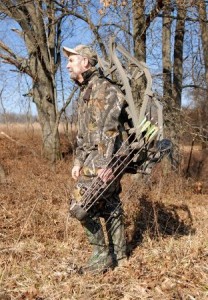
Scouting for a productive funnel is not as risky as walking thick
brush and woods. Funnels also
provide easy access for you to
reach your stand.
(Photo by John & Vikki Trout)
Although I previously mentioned the importance of cover, funnels must link to a deer’s needs. I’ve seen some funnels that connected to a bedding area on one end, but end up falling apart 100 yards before getting to a crop field. Deer often follow these limited funnels to get to a food source, but they are not as effective as those that link to brush and/or woods at both ends.
Funnels often pass through open areas, providing easy access for scouting and hunting. It’s best to scout the funnel from one end to the other to look for trails, avoiding the densest cover to keep from leaving scent. Also, look for rub lines and scrapes if the rut is near. Bucks love to leave their sign in funnels consistently used by does. Moreover, they love leaving their marks at each end of the funnel where it links to woods and thickets.
5 – The Ambush
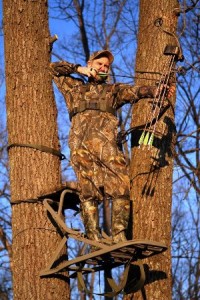
Narrow funnels could offer more shooting opportunity than wide ones. Even if a trail exists near the edge, it might be best to set up closer to the middle of the funnel where you can accurately shoot from edge-to-edge.
(Photo by John & Vikki Trout)
Setting up a stand in the right location along a funnel is often difficult. More often than not, I choose a site at one end or the other not far from where the funnel links to a woods or thicket.
It doesn’t take a funnel several hundred yards long to work. In fact, the shorter the funnel, the less chance of a buck finding a reason to leave the funnel before he gets to you. As for width of the funnel, narrower is better when archery hunting. There’s nothing better than being able to shoot across the funnel from one edge to the other. Hunting with a firearm will allow you to cover a wider funnel more effectively, but even then some funnels are so thick with cover that you are better off setting up in the middle.
One last thing should be mentioned about funnels. Some are reliable season-after-season. When you find one that is, you don’t have to look for another.
***
About John Trout, Jr
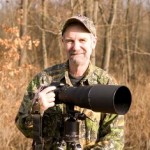 Southern Indiana hunter John Trout, Jr. is a full-time freelance writer and photographer specializing in whitetail deer, wild turkey and black bear. He has authored eight books and his work has appeared in nearly every publication of North America. You can visit his website at www.troutswildoutdoors.com.
Southern Indiana hunter John Trout, Jr. is a full-time freelance writer and photographer specializing in whitetail deer, wild turkey and black bear. He has authored eight books and his work has appeared in nearly every publication of North America. You can visit his website at www.troutswildoutdoors.com.
Click here for more how-to’s and tips on deer hunting,
and for the best deer skinning knife, click here.
13,002 total views, no views today


